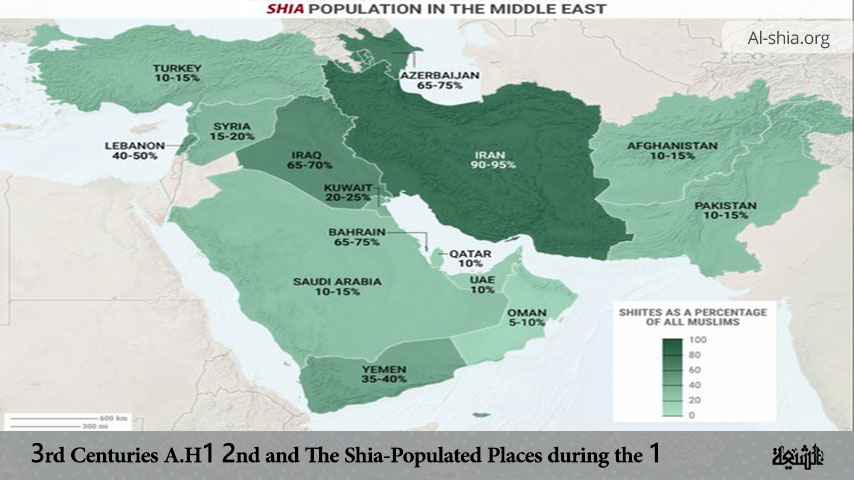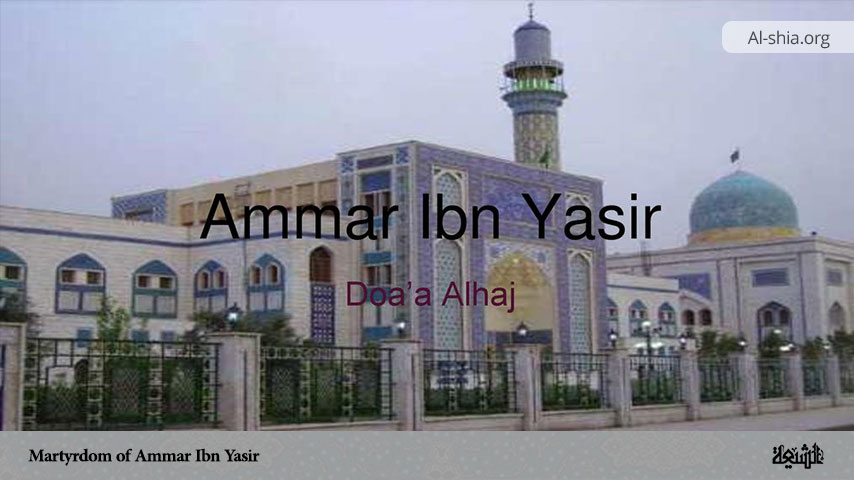At the beginning of the second century AH, Shia extended beyond the frontiers of the Arabian Peninsula and Iraq as it encompassed the entire Muslim domain.
In view of the scattering of the Shia and ‘Alawis in the Muslim territories, this matter can be discerned.
From the time of Hajjaj ibn Yusuf, the migration of the Shia and ‘Alawis to the other regions had begun.
These migrations were further expedited during the second century AH with the beginning of the propaganda and movements by the ‘Alawis.
After the failure of the uprising of Zayd in Kufah, his son Yahya along with a number of his supporters went to Khurasan. (1)
After him, the uprising of ‘Abd Allah ibn Mu‘awiyah, a descendant of Ja‘far ibn Abi Talib at-Tayyar, covered the regions such as Hamedan, Qum, Rey, Qirmis, Isfahan, and Fars, and ‘Abd Allah himself lived in Isfahan.
Abu’l-Faraj al-Isfahani says, “The notables of Banu Hashim went to him and he designated each of them to rule over a district.
Even Mansur and Safah (who later became the first two ‘Abbasid caliphs) had connivance with him and this continued till the time of Marwan Himar and the emergence of Abu Muslim.”(2)
During the ‘Abbasid period, the ‘Alawi movements always emerged, one definite consequence of which was the scattering of the ‘Alawis in the different regions.
For example, after the uprising of Muhammad Nafs az-Zakiyyah during the reign of Mansur and his defeat, the descendants of Imam al-Hasan (‘a) were scattered in different places.
In this regard, Mas‘udi thus says:
The brothers of Muhammad ibn ‘Abd Allah (Nafs az-Zakiyyah) were scattered in different places. His son, ‘Ali ibn Muhammad, went to Egypt where he was killed later. His other son, ‘Abd Allah ibn Muhammad, went to Khurasan and from there proceeded to Sind where he was killed. His third son, Hasan ibn Muhammad went to Yemen where he was put behind bars and passed away while in prison. His (Nafs az-Zakiyyah’s) brother, Musa, went to Mesopotamia.
Another brother of Nafs az-Zakiyyah, Yahya, went to Rey and from there he proceeded to Tabaristan. Another brother of his, Idris, went to Maghrib.
Yet another brother, Ibrahim, went to Basrah where he formed an army composed of men from Ahwaz, Fars among other cities, but his uprising ended in failure. (3)
Although most of them were pursued by the ‘Abbasid agents and were unable to remain in one place and were later killed, their impact remained.
Sometimes, their children lived in those places. For example, ‘Abd Allah, son of Muhammad Nafs az-Zakiyyah, as narrated by Mas‘udi, was not able to remain in Khurasan and thus, he went to Sind. (4)
Yet, the author of the book, Muntaqilah at-Talibiyyin, narrates that the son of ‘Abd Allah, Ibrahim, remained in Khurasan and had two sons named Qasim and Muhammad. (5)
Similarly, there was a group in Transoxiana which was tracing itself back to Ibrahim ibn Muhammad Nafs az-Zakiyyah. (6)
Shiite Cities during the second century AH
Now, we shall survey the condition of the cities and regions in which the Shia lived in large numbers during the second century AH.
Khurasan
At the beginning of the second century AH, the movement of the campaigners of Banu Hashim (7) commenced in Khurasan and many people there embraced Shi‘ism.
Ya‘qubi narrates, When Zayd was martyred, the Shia in Khurasan were in the great commotion and expressed their faith in Shi‘ism.
The preachers were openly stating the atrocity and tyranny of the Umayyads against the descendants of the Prophet (S). (8)
It remained so until such time that Yahya ibn Zayd went to Khurasan and lived there in disguise for some time. And when he rose up, many people gathered around him. (9)
Mas‘udi narrates, “On the year when Yahya was killed, every infant that was born in Khurasan was named Yahya.” (10)
Of course, due to the presence of Zaydis and ‘Abbasid campaigners, Shi‘ism of the people of Khurasan had more Zaydi and Kaysani colours.
This is particularly true in view of the fact that in the beginning, the ‘Abbasids laid the foundation of their legitimacy upon the succession of Muhammad ibn ‘Ali to Abu Hashim, son of Muhammad al-Hanafiyyah.
As Abu’l-Faraj al-Isfahani writes in describing ‘Abd Allah ibn Muhammad al-Hanafiyyah:
He is the same person whom the Shia of Khurasan were thinking to be the heir of his father whom they thought was the Imam. His heir in turn was Muhammad ibn ‘Ali ibn ‘Abd Allah ibn al-‘Abbas while Muhammad ibn ‘Ali designated Ibrahim as his successor. In this manner, succession among the Abbasids was institutionalized. (11)
The Khurasanis had always been supporters of the ‘Abbasids, and when the dichotomy between the ‘Alawis and ‘Abbasids occurred, they sided with the latter.
For example, during the battle against Muhammad Nafs az-Zakiyyah, most of the ‘Abbasid soldiers were Persian-speaking Khurasanis.
Abu’l-Faraj al-Isfahani narrates: When Khudayr Zubayri, one of the commanders of Muhammad Nafs az-Zakiyyah, was coming to the battlefield from Medina, the Khurasanis were saying in Persian, “Khudhayr amad; Khudhayr amad” {Khudhayr came; Khudhayr came}. (12)
Qum
Qum has been one of the most important Shia-populated cities since the second century AH. This city, apart from being founded after the advent of Islam, has been founded by the Shia and Shia resided in and populated it from the very beginning. It is Shia Imamiyyah that has always been there without experiencing any deviation.
Not only have Sinyan ever lived there but also the Ghulat did not find their way there, and even if they had, the people would have rejected them. (13)
Many of the people there used to come to the pure Imams (‘a) to learn from these great personages, always maintaining contact with their Imams.
In 82 AH when the revolt of Ibn Ash‘ath against Hajjaj was crushed and he fled to Kabul, (14) a number of his soldiers were also Shia such as ‘Abd Allah, Ahwaz, Na‘im, ‘Abd ar-Rahman, and Ishaq, sons of Sa‘d ibn Malik ibn ‘Amir al-Ash‘ari, who went to the districts of Qum after the defeat of Ash‘ath.
There were seven villages there one of which was known as “Kamandan”. After these brothers’ stay in this village, their kith and kin joined them and resided in all the seven villages.
Gradually, these seven villages merged together and they all become “Kamandan”. Kamandan was Arabized and shortened into “Qum”. (15)
From then on, Qum has become one of the most important concentration centres of the Shia, and the ‘Alawis in particular, who arrived and resided there from everywhere. (16)
At the end of the second century AH, the arrival of Lady Fatimah al-Ma‘sumah (Imam al-Ridha’s (‘a) sister) is considered the turning point in the history of this city, bringing about ample blessings to it.
Continued in the next article: http://The Shia-Populated Places during the 2nd and 3rd Centuries A.H (2)
NOTES:
____________________________
1. ‘Ali ibn al-Husayn Abu’l-Faraj al-Isfahani, Maqatil at-Talibiyyin (Qum: Manshurat ash-Sharif ar-Radi, 1416 AH), p. 146.
2. Ibid., p. 157.
3. 3‘Ali ibn Husayn ibn ‘Ali Mas‘udi, Murawwij adh-Dhahab, 1st edition (Beirut: Manshurat Mu’assasah al-A‘lami Li’l-Matbu‘at, 1411 AH), vol. 3, p. 326.
4. bid.
5. Abu Isma‘il ibn Nasir ibn Tabataba, Muntaqilah at-Talibiyyin, trans. Muhammad Rida ‘Ata’i, 1st edition (Mashhad: Intisharat-e Astan-e Quds-e Radhawi, 1372 AHS), p. 207.
6. Ibid.
7. It must be noted that the term, “Banu Hashim” or “Hashimiyan” at the time also included the ‘Abbasids as they were also grandchildren of Hashim.
8. Ibn Wadhih, Tarikh al-Ya‘qubi, 1st edition (Qum: Manshurat ash-Sharif ar-Radi, 1414 AH), vol. 2, p. 171.
9. Maqatil at-Talibiyyin, p. 149.
10. Murawwij adh-Dhahab, p. 336.
11. Maqatil at-Talibiyyin, p. 123.
12. Ibid., p. 238.
13. Rijal ibn Dawud (Qum: Manshurat ar-Radhi, n.d.), pp. 240, 270.
14. Murawwij adh-Dhahab, vol. 3, p. 149.
15. Shahab ad-Din Abi ‘Abd Allah Yaqut Hamawi, Mu‘jam al-Buldan, 1st edition (Beirut: Dar Ihya’ at-Turath al-‘Arabi, 1417 AH), vol. 7, p. 88.
16. Muntaqilah at-Talibiyyin, pp. 333-339.


















